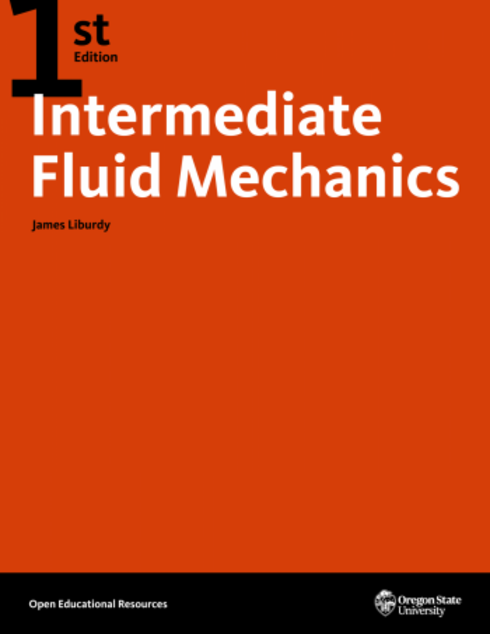
Intermediate Fluid Mechanics
![]()
![]()
![]()
![]()
![]()
James Liburdy, Oregon State University
Copyright Year: 2021
ISBN 13: 9781955101103
Publisher: Oregon State University
Language: English
Formats Available
Conditions of Use
![]() Attribution-NonCommercial-ShareAlike
Attribution-NonCommercial-ShareAlike
CC BY-NC-SA
Reviews
The text does not cover all areas and ides of the topics, instead ,for example, briefly covers some topics such as CFD read more
![]()
![]()
![]()
![]()
![]()
The text does not cover all areas and ides of the topics, instead ,for example, briefly covers some topics such as CFD
There are grammar mistakes but unbiased content.
Content is not up-to-date, all topics is analysis of well-known fluid Mechanics equations, such as Bernoulli and Navier Stokes equations and are briefly discussed
The text is written in a clear way and accessible, but some equations are written in complex way, for example, Bernoulli Equation is written in vector notation which makes it complicated for some readers.
The text is consistent in terms of terminology and framework.
The text is divided to smaller to moderate reading sections as needed and easy to read, there are titles and subtitles.
The topics in the text are presented in a logical, and in some points also in clear fashion.
The text is free of significant interface issues. The contents page contains links take the reader to each topic individually if click in that link.
text contains grammatical errors such as but not limited to
streamfunction, page42
has lead , page 124
occurs, and spatio-temporal variations page 151
data bases, page165
The text is not offensive in any way.
I do not recommend this book for undergraduate students who will study fluid mechanics for the first time because there are no solved examples provided to apply the fluid mechanics concepts or examples that are applied to real-life problems.
The book is compreshensive for the areas it covers, but it only has a table of contents and lacks both an index and a glossary. As it has been several years since I worked with fluid dynamics and tensor calculus, I really noticed the absence. An... read more
![]()
![]()
![]()
![]()
![]()
The book is compreshensive for the areas it covers, but it only has a table of contents and lacks both an index and a glossary. As it has been several years since I worked with fluid dynamics and tensor calculus, I really noticed the absence. An effective index and glossary would increase this rating to a five.
I did not notice any content errors in the book although the print PDF version had Latex code showing instead of the symbol or equation in several areas.
The content uses well-established theory.
Overall, I found the prose clear and understandable.
Overall the book is internally consistent, although I did find a couple of headings that used a different font and/or case than others at the same level.
The book has an adequate number of subheadings that will make assigning readable "chunks" possible.
Content is developed logically from previously introduced concepts.
I used the Print PDF version for review. Overall, it was consistent, but in several captions, Latex code was present rather than the symbols. Overall, figures use vector graphics so they are clear at different zooms, but Figure 2.3 appears to be a PNG image rather than using vector graphics, so some of the curves and text have artifacts. Also, the lift coefficient equation is still in Latex rather than rendering as an equation.
Overall, grammar is meets expectations and is internally consistent.
The book does not have human actors, and does not reference cultural issues.
Overall, I appreciated the book and found it to be a good refresher. It is primarily a reference book rather than a text book as it has no problems for students to work. The biggest drawback for me was lack of an index and glossary. The book referred several times to another book on Viscous Fluid Flow by F.M. White, and it would have been nice to have a full reference to the work in a references section.
Table of Contents
- I. Introduction
- II. Mathematical Tools
- III. Bernoulli Equation
- IV. Potential Flow Basics
- V. Potential Flows
- VI. The Panel Method: An Introduction
- VII. Introduction to Viscous Flows
- VIII. Boundary Layer Flows
- IX. Integral Boundary Layer Relationships
- X. Introduction to Turbulence Effects
Ancillary Material
Submit ancillary resourceAbout the Book
This book is meant to be a second course in fluid mechanics that stresses applications dealing with external potential flows and intermediate viscous flows. Students are expected to have some background in some of the fundamental concepts of the definition of a fluid, hydrostatics, use of control volume conservation principles, initial exposure to the Navier-Stokes equations, and some elements of flow kinematics, such as streamlines and vorticity. It is not meant to be an in-depth study of potential flow or viscous flow, but is meant to expose students to additional analysis techniques for both of these categories of flows. We will see applications to aerodynamics, with analysis methods able to determine forces on arbitrary bodies. We will also examine some of the exact solutions of the Navier-Stokes equations based on classical fluid mechanics. Finally we will explore the complexities of turbulent flows and how for boundary layer flows one can predict drag forces. This compilation is drafted from notes used in the course Intermediate Fluid Mechanics, offered to seniors and first year graduate students who have a background in mechanical engineering or a closely related area.
About the Contributors
Author
James Liburdy, Oregon State University
